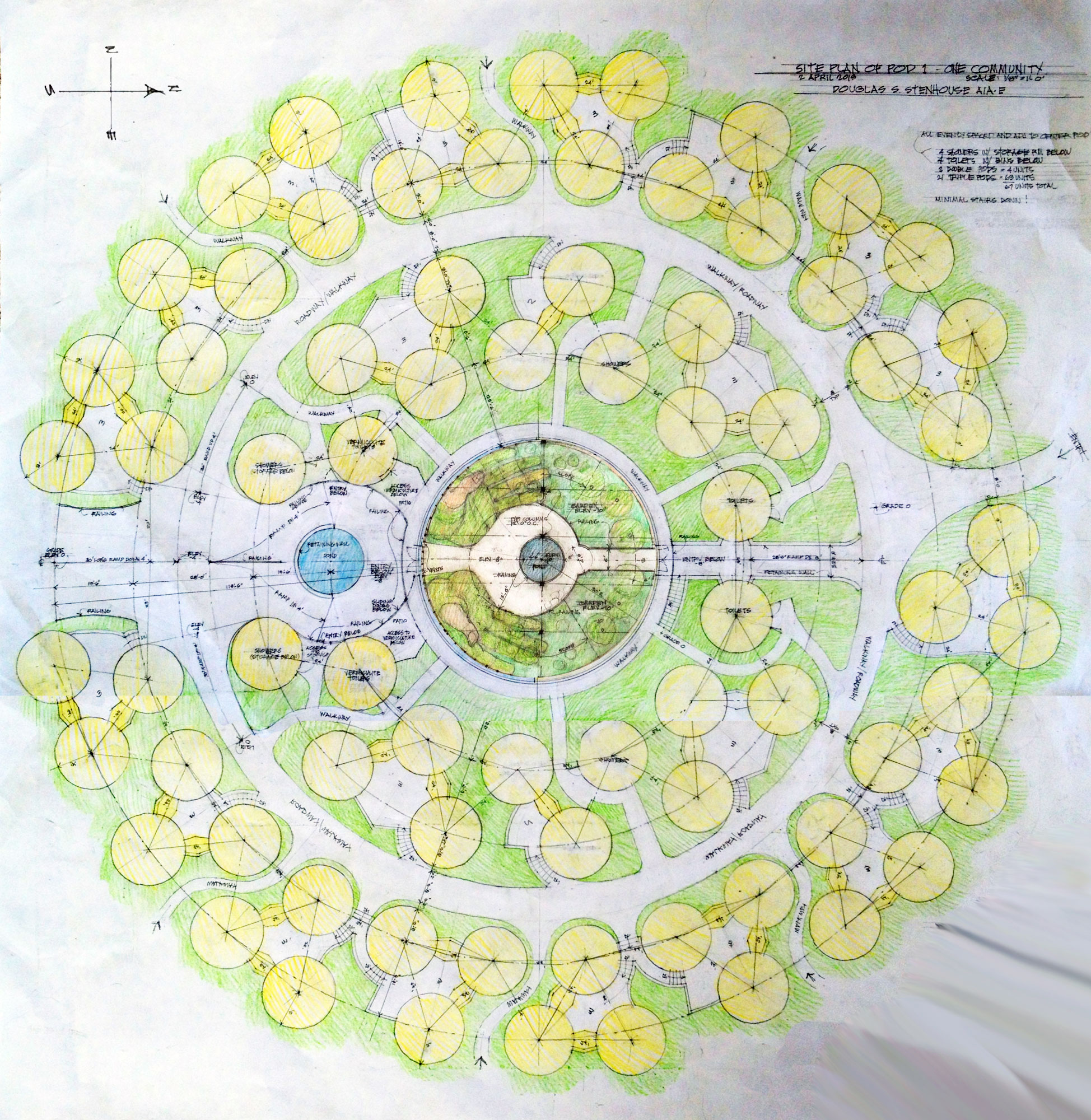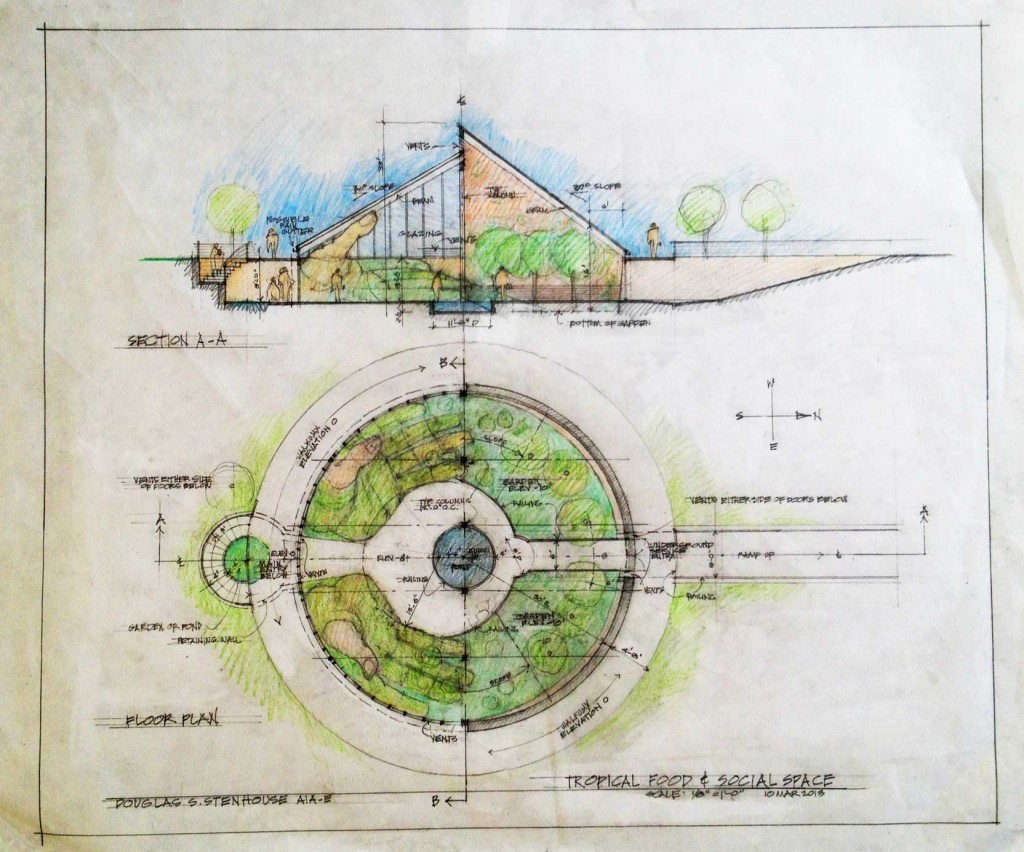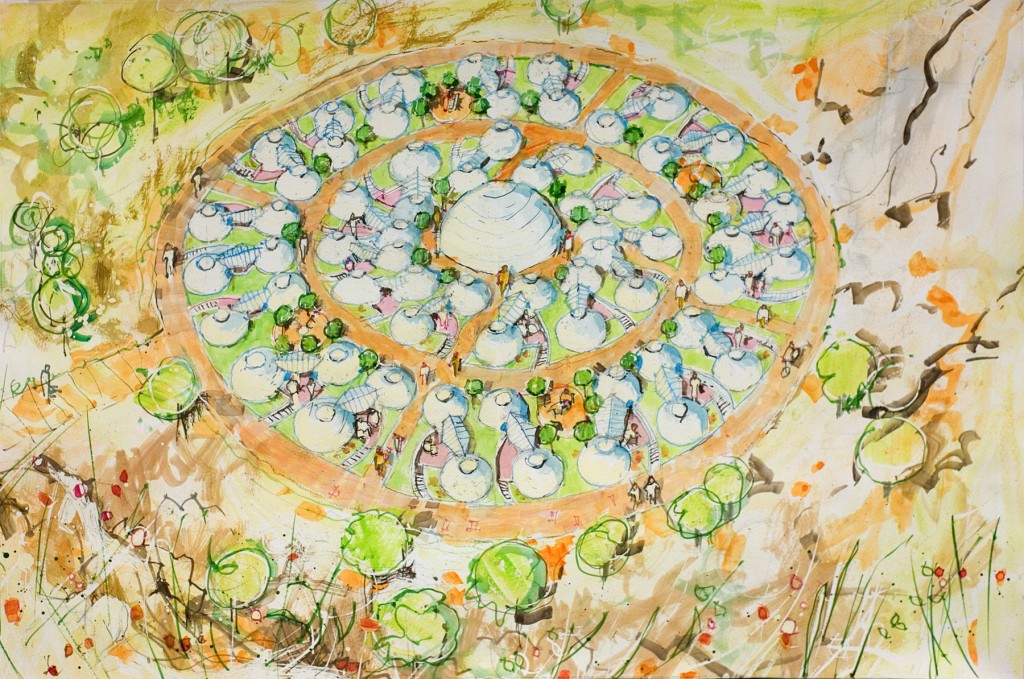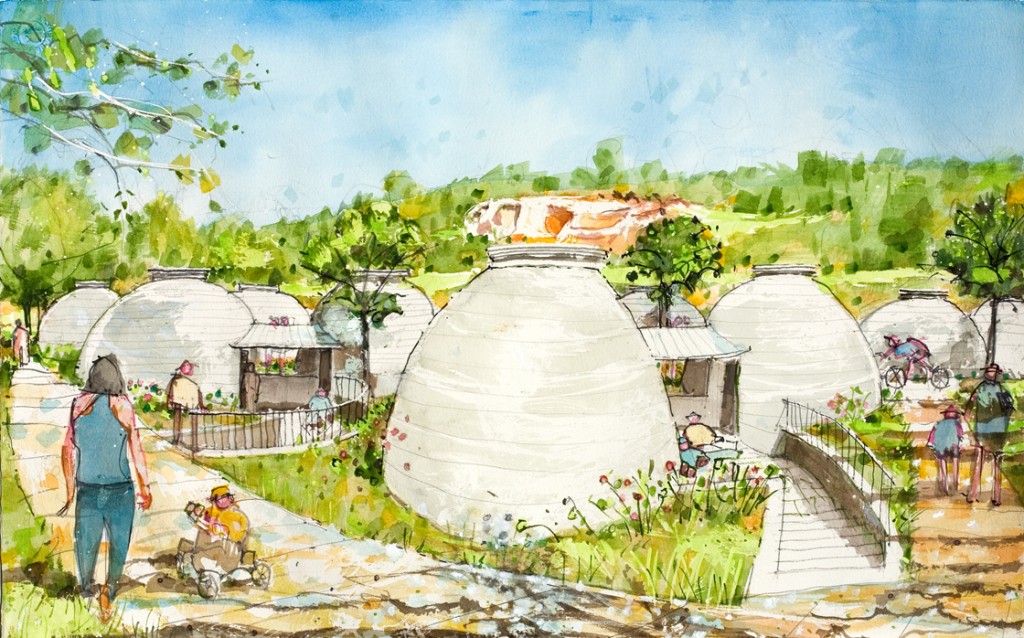Earthbag Village – One Community Pod One
In accordance with our four-phase global change strategy, we are open source project-launch blueprinting the earthbag village (Pod 1) first as maximally affordable sustainable housing. We will showcase this as an artistic, durable, easy to build, and completely ecologically friendly and sustainable home model that can be constructed for under $1000 per structure from materials that can be locally sourced or easily and affordably shipped anywhere in the world. The 150-200 square foot size free-standing structures design will allow most people in most counties in the US to duplicate our designs without permits (ours will be permitted) and, as we build the 75 structures of this village model at One Community, we will explore and demonstrate a broad diversity of artistic external and functional internal options that we will also open source share to increase interest and global support for this method as a duplicable teacher/demonstration community, village, and city construction option. We are currently in the process of working on everything necessary for permitting these structures and will open source share this process once it is complete. Through the permitting process of Pod 1, we are learning what we will need to start applying for the necessary permits to build Pod 2.
RELATED PAGES
WAYS TO CONTRIBUTE TO EVOLVING THIS SUSTAINABILITY COMPONENT WITH US
EARTHBAG VILLAGE OPEN SOURCE PORTAL
As we continue open source project-launch blueprinting the earthbag village, build it, and problem solve and evolve it for One Community (and with others around the world) we will use this page as the portal to complete details for duplication including the additional portals for the vermiculture bathroom designs, eco showers, and Tropical Atrium, as well as the open source and free-shared specifics related to this village model including:
● Architectural plans for all components● Detailed materials list for all components
● Detailed equipment and tools needs list for all components
● Cost analysis and best sources for materials and equipment
● How to build, what to watch out for, how to adapt structure
● How to work with local government if permitting is needed
● On-going maintenance and upkeep details per our on-going experience
● Specifics of everything you can grow in the Tropical Atrium and what kinds of yields you can expect
● Complete details on how to build your own Earth Bag Village and how many hours it should take
● How to make your build easier than ours and how to solve any problems we encountered in our build
● Archive and database of others building similar structures including their experiences, adaptations, etc.
● List of everyone who helped us design and build this so they can be contacted to help others change it
The list above will evolve into links for each bullet point to individual pages including all the open source project-launch blueprinting details people need to duplicate every aspect of this component of One Community in part or in whole.
EARTHBAG VILLAGE LAYOUT OVERVIEW
MORE EARTHBAG VILLAGE DETAILS
FEATURES
● 67 living units● Earthbag construction
● Water collection from all structures
● Demonstrates 2 different eco-waste disposal systems
● Communal use bathroom and shower designs and layout
● Reuse of greywater for the Tropical Atrium and agriculture
● Should be completed in 12-18 months so we can start on Pod 2
● Central Tropical Atrium doubles as meditation and class space
● Maximization of artistic external and internal design exploration and use
● The most minimalist and easy design of any pod demonstrating a model that will be able to be duplicated and produce a home that can be built anywhere in the world for under $1,500
● The tropical trees (associated growing height in parenthesis) we are thinking of are: banana (12′), mango (8-12 feet), starfruit (12′), fig (10′), loquat (15′), Miracle Fruit (6′), Papaya (6′), Persimmon (15′), Pineapple (3-4′) and Chocolate (15′) with Kiwi vines to fill in the extra space
EARTHBAG DOME POSSIBLE FURNITURE LAYOUTS
The earthbag (Pod One) village is the first of the seven different sustainable village models to be built because it is designed to demonstrate and teach maximally affordable living. It consists of sixty-seven 150-200 square foot semi-subterranean earthbag hotel room styled cabanas built in trios or pairs with a central sitting area designed for relaxation and growing a small shared garden. Like a hotel or dorm room, each dome will consist of a bed, dresser(s), and a small sitting area and desk. Communal use bathrooms and showers will be within a short walk and will integrate recycling of all water and a combination vermiculture and traditional septic eco-friendly bathroom (see below). These bungalows will be heated by rocket mass heaters and kept cool via the semi-subterranean construction and passive cooling. Electricity and heat for all homes and the central Tropical Atrium will be provided by solar (see energy infrastructure page).

ADDITIONAL DESIGN ELEMENTS
● Interior Floors will be made of three layer clay floor, as per Ianto Evans’ Hand Sculpted Houses Book● Exterior walkways between the dry and wet domes will be made of flat rammed earth with natural rock stepping stones harvested locally
● Retaining walls along the walkway will be built in a stair or terrace like method using superadobe layers so that after every 4 layers a little terrace will be created by stepping back the next four layers by 20 inches
● Covering the walkway between the two domes will be done by installing rafters between the domes in between the superadobe layers once all the bags are in place with 6 mil plastic foil installed on top and fast growing shade plants (e.g. mandrake, wild-grape etc.) growing over the top of that
● We are shooting for 100% water for Pod 1 to be supplied by surrounding water catchment
● Grey water will be treated with the same methods used in earthships (still needing to be designed)
● External waterproofing will be done as follows:
- Stabilized rough plaster layer applied on earthbags
- Low VOC asphalt emulsion applied on top of rough plaster
- 16”x16” earthbag pieces soaked in low VOC asphalt emulsion is layered on top of layer 2, with overlaps in a pine cone pattern
- Fine plaster cover applied on top of previous layers
- Lime paint layers applied on top of fine plaster “Penetron”
COMMUNAL BATHROOM INTEGRATING VERMICULTURE AND TRADITIONAL SEPTIC
We continue to evolve the designs below (click here for our Updates and Progress Page covering everything we are working on) and discussion with the county has shown that we would need to plumb this entire structure for traditional septic even if we weren’t planning on using it. Thinking about this with our open source goals and strategy for sharing sustainability with the world, we are now designing communal bathrooms that will connect to a traditional septic while also offering vermiculture options. These designs we are still developing will:
● Allow us to meet county requirements while we demonstrate more sustainable models with the vermiculture and other eco-options we are exploring and purposed to build and open source free-share● Allow others with similar local level restrictions to duplicate what we are doing and further validate the effectiveness of more sustainable models
● Allow us to demonstrate a safe and sustainable option that does not require septicfor third world countries and others that might not have the resources for traditional septic, don’t have the same restrictions we have, and/or could benefit from the alternatives we are designing and will demonstrate
● Allow us to demonstrate this pod as 64 living units versus 32 while maintaining our cost projections despite the installation of a traditional septic system attached to each of our communal bathrooms
This Pod’s evolution still has room for design and permitting help
MORE IMAGES OF THE EVOLUTION OF THIS VILLAGE MODEL
CLICK IMAGES TO ENLARGE





No comments:
Post a Comment